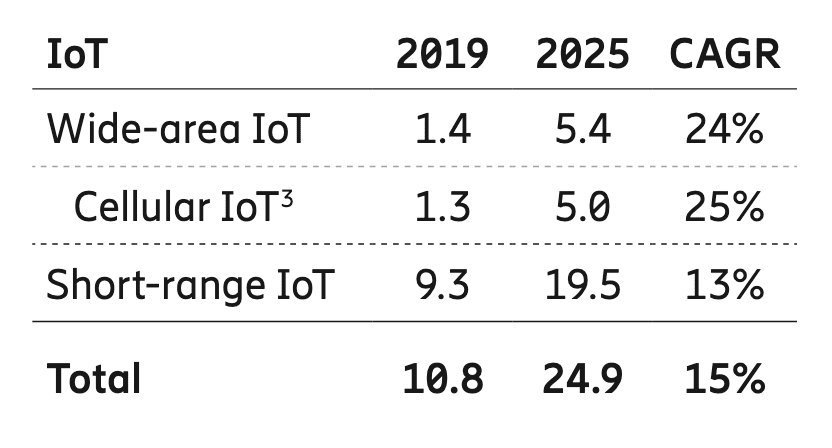The number of cellular IoT connections will reach five billion by the end of 2025, from 1.3 billion by the end of 2019, according to Ericsson. Around a half will be NB-IoT and LTE-M connections, and around a quarter will be on LTE and 5G.
The Swedish vendor’s latest mobility report says the total number of 5G connections, by comparison, will be 2.6 billion at the end of the period, from a standing start today. The total number of mobile subscriptions is around eight billion, at the end of the third quarter of 2019.
Cellular IoT connections will increase at a compund annual rate of 25 per cent per year through to the end of 2025. NB-IoT and LTE-M (Cat-M) will account for 52 per cent of cellular IoT connections by the end of period, reckons Ericsson. Their number has spiralled three-fold in 2019, and will reach close to 100 million by the end of the year, said Ericsson.

So far, 114 service providers have switched on either NB-IoT or LTE-M; around one in four have launched both simultaneously. As it stands, the remainder of the 1.3 million celluar IoT connections – indeed, the lion’s share – are on legacy 2G and 3G networks.
North East Asia is leading the global adoption of cellular IoT. At the end of 2019, it is estimated that the region will account for 60 per cent of all cellular IoT connections, a figure set to increase to 68 per cent in 2025. “This reflects both the ambition and size of the cellular IoT market in this region,” said Ericsson.
Other non-cellular IoT technologies, such as LoRaWAN and Sigfox, are not included in the Ericsson count. NB-IoT and LTE-M, referred to as ‘massive IoT’ technologies by Ericsson, in line with the 3GPP’s 5G specification for ‘massive machine-type comms’ (mMTC), will overtake legacy M2M technologies in 2023, and take double the volume in 2025, calculates Ericsson.
Mobile broadband based IoT connections requiring higher throughput and lower latency – mostly using LTE, grouped by Ericsson as ‘wide-area IoT’ – will comprise 28 per cent of all cellular IoT connections by the end of 2025, from around 20 per cent today. This segment will also include industrial and mission-critical 5G connections, based on 5G specificatons for ultra-reliable low latency comms (URLLC) in Release 16.

Ericsson noted: “Critical IoT includes both wide-area and local-area use cases that have requirements for extremely low latency and ultra-high reliability. The first modules supporting critical IoT use cases are expected to be deployed in 2020. Only a small fraction of total cellular IoT connections will be critical IoT in 2025.”
The latest bi-annual mobility report from Ericsson says 5G will cover up to 65 per cent of the world’s population by the end of 2025 and handle 45 per cent of global mobile data traffic.
Fredrik Jejdling, executive vice president and head of networks at Ericsson, remarked: “It is encouraging to see 5G now has broad support from almost all device makers. In 2020, 5G-compatible devices will enter the volume market, which will scale up 5G adoption. The question is no longer if, but how quickly we can convert use cases into relevant applications for consumers and enterprises.”
See RCR Wireless’ write-up of the report, covering the main consumer 5G angles.

